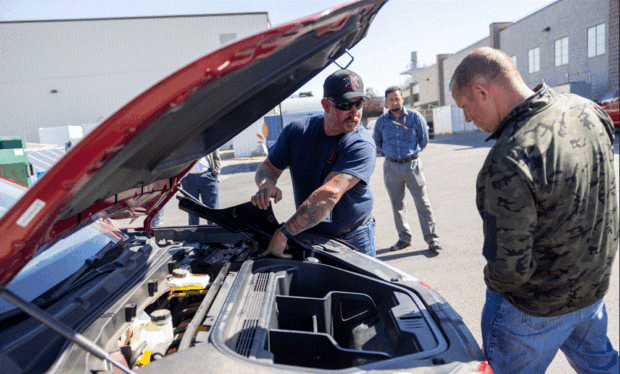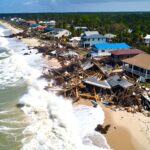An EV battery workshop, held by the Idaho National Laboratory (INL) for firefighters from four eastern Idaho fire departments, highlighted the risks associated with electrical vehicle (EV) batteries.
According to Randy Bewley, a researcher at INL’s Battery Test Center, even if the fire appears to be out, it can reignite later. It’s the reason why electric vehicles (EV) in salvage yards are kept by themselves and spaced far apart.
Lithium-ion batteries hold a lot of energy, and if one catches fire, it’s sometimes hard for firefighters to extinguish the blaze.
If an EV battery catches fire, the best outcome any firefighter can achieve is keeping it from destroying nearby property.
“There’s no way to stop it until the chemical energy is released,” Bewley said. “The only thing you currently can do is hit it with a lot of water in hopes of containing it.”
A fire blanket can help, but the main concern should be keeping the fire from spreading — especially to other EVs.
As more EVs hit the road, the likelihood of accidents involving them will increase.
While firefighters have extinguished internal combustion vehicle blazes for decades, there is currently no effective flame suppressant or retardant that will put out a lithium-ion battery fire.
In the fall of 2024, hurricanes Helene and Milton emphasized the need for more education around EV fires.
Following Helene, Florida officials issued a warning to residents and first responders about the fire hazards associated with lithium-ion batteries inundated with seawater. At the time, Florida officials confirmed 11 lithium-ion battery fires related to Helene’s storm surge involved EVs. Others were related to consumer items, such as scooters, hoverboards, golf carts and children’s toys.
So far, no EV fires have been reported in eastern Idaho.
Some of the 13 firefighters at the INL workshop said they’d seen battery fires involving power tools and toys, but only one said he’d been involved with an EV fire.
Before joining the Madison Fire Department four years ago, training officer Andrew Sharp said he helped contain a Tesla fire in California.
“We had to clear all the exposures and let it burn,” he said. “That’s all we could do.”
After the seawater from Hurricane Ian in 2022 compromised the batteries of as many as 5,000 EVs, the National Highway Traffic Safety Administration asked INL engineers to conduct teardown research on ten of the cars to understand the impacts of flooding on their batteries.
To continue their research, Tanim and his colleagues are building an EV/battery immersion test facility at INL’s Central Facilities Area. With the work almost complete, Tanim said they hope by next summer to start conducting full-scale immersion tests to better identify the root causes of flood-induced battery problems.
Most EV batteries are made by reputable manufacturers and pose little danger of suddenly catching fire due to flaws in the manufacturing process, though there have been recalls related to battery fires in recent years. It’s when they are compromised, damaged or punctured that they become dangerous.
“If you damage a cell, it will react,” Bewley said.
Bewley advised the participants at the workshop to gather every emergency response guide for every model of EV on the road and study them.
Every EV has a “cutline” for disconnecting the battery from an EV’s power converting module, but the location varies from model to model.
An EV battery typically carries 400 volts, and some newer vehicles are looking at a higher voltage battery pack design, so its direct current can be lethal.
“You need to be mindful of the fact that there is a lot of energy in those batteries. A fully charged 100 kilowatt-hour battery can generate 1072 horsepower for seven minutes,” Bewley said.
Even if there hasn’t been a fire, taking a damaged EV or hybrid vehicle to a salvage yard has its challenges.
In many models, the drive wheels charge the battery (via regenerative braking), so the vehicle must be loaded onto a flatbed or dolly to prevent overcharging.
There are currently no regulations governing EV battery disposal or resale.
If someone wants to replace the battery in their Tesla, there’s no certification process governing batteries retrieved at salvage yards.
Challenges for responders break down into four areas: personal safety, public safety, rescue and safety for those involved, and understanding the hazards.
“In the future, this may get more complicated,” Bewley said. “Understanding is going to come with time.”
Battelle Energy Alliance manages INL for the U.S. Department of Energy’s Office of Nuclear Energy. INL is the nation’s center for nuclear energy research and development, and also performs research in each of DOE’s strategic goal areas: energy, national security, science and the environment.
Original article by Paul Menser, Idaho National Laboratory.





















 The Latest Launches from Allstate, WTW, Whisker Labs
The Latest Launches from Allstate, WTW, Whisker Labs  Executives on the Move at HSB, American Modern Insurance Group, AIG
Executives on the Move at HSB, American Modern Insurance Group, AIG  Rebuilding Negotiation Talent: Why This Skill Is Missing and How to Fix It
Rebuilding Negotiation Talent: Why This Skill Is Missing and How to Fix It  How One MGU Grew Fivefold When Capacity Fled Cat-Prone Property Markets
How One MGU Grew Fivefold When Capacity Fled Cat-Prone Property Markets 




